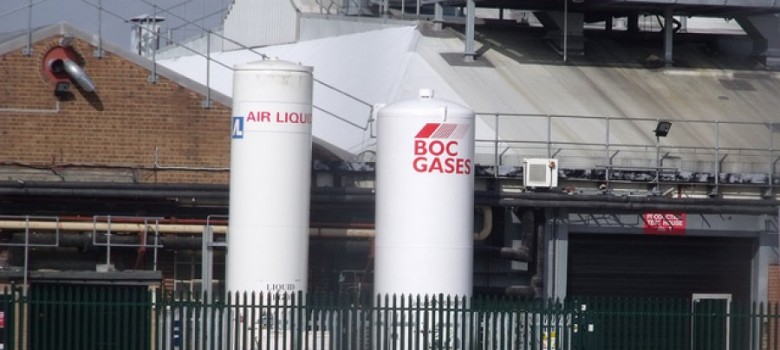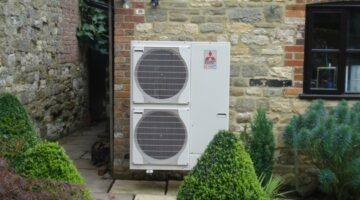
What is Liquid Air Energy Storage?
Liquid Air Energy Storage (LAES) is a form of storing excess energy just as CAES (Compressed Air Energy Storage) or other battery storage systems. The system is based on separating carbon dioxide and water vapour from the air to produce a higher concentration of nitrogen. This nitrogen can then be liquefied for storage and expanded back to a gas when we need to make electricity. Liquid nitrogen is a commonly used substance in current industrial processes and can be stored and transported in large volumes at atmospheric pressure. This is different to the CAES process, which requires high-pressure storage chambers. Liquid nitrogen is also a good substance because it has a high expansion rate. In fact, it expands 700 times in volume when turning back into a gas from a liquid.
The LAES form of storage works well with intermittent power sources like wind and solar power, because the additional electricity created can be used to help filter the air into nitrogen, and then turn it into a liquid form. The electricity is recreated when the liquid is expanded to turn into its gas form.
How does the Liquid Air Storage process actually work?
The process depends on using liquefied air or liquid nitrogen (78% of air), which can be stored in large volumes at atmospheric pressure. The air is taken through an inlet and then into a compressor. On entering the compressor air is made up of a percentage of oxygen, water vapour, carbon dioxide and mostly nitrogen. When too much electricity is generated, the excess electricity is used to power the compressor and the chilling unit. Here the nitrogen component is separated and further cooled so it forms into a liquid, at precisely -196°C. The liquid nitrogen is then stored in a chilled vacuum until it is needed to drive power recovery. If there is a peak in demand or if the grid is struggling to meet demand, the liquid nitrogen can help with this. Then first step is to transfer the liquid into an ambient temperature chamber, usually into a heat exchanger. Since liquid air boils at -196°C, any small change to ambient temperature will superheat it. This creates expansion as the liquid once again becomes a gas. The expanding steam then drives a turbine (cryogenic engine), which drives the standard electric generator. Upon creating the electricity, it can then be reconnected and integrated back into the grid.
Can Liquid Air Storage energy be a commercially viable solution?
According to the Institute for Mechanical Engineers (IMechE), the process is anywhere between 25% and 70% efficient. This means that up to 70% of the electricity can be recreated from the cryogenic air compression process explained above. The process becomes more efficient if the cryogenic chambers, air vacuums and generator are located near a factory or an existing power station. This is because excess heat is usually vented, but it can be used efficiently in the LAES process. However despite a possible 70% efficiency, it is worth noting that batteries have an efficiency of 80%. Therefore, to be commercially viable, a cryogenic LAES plant needs to be able to achieve even more efficiency. Ideally the cryogenic LAES plant should also be located close to an intermittent renewable source of energy such as solar PV, wind power or marine energy, so that it can minimise the electricity and heat loss during the transmission process.
How can Liquid Air Energy Storage combat volatilities in electricity demand?
The main challenge we all have is how to deal with erratic demand for electricity and somewhat intermittent supply from non-traditional sources like wind, solar and marine energy. One of the answers could be to use a solution like LEAS to store energy when it is plentiful and then use the storage to convert it back to electricity to meet demand. Therefore current power grids need to be upgraded so they are able to work smarter in order that energy can be provided when it is needed. Many argue that wind, solar and marine energy generation are tied to local environmental conditions, and there is no point transporting this energy around the country via the grid because much of it is lost through the transformation process. Therefore having LAES solutions sitting alongside more responsive local grids is something that should also be considered rather than just applying storage to an already inefficient national grid.
How does Liquid Air Storage compare to Compressed Air Energy Storage?
The energy density of cryogenically frozen fluids, such as liquid nitrogen compares very well against current alternatives such as compressed air, mainly because it can be used and transported under atmospheric pressure. Compressed air needs to be stored in special pressurised tanks, which are liable to leaks. Also compressed air requires special storage space underground, like mining shafts, which are limited in availability.
Liquid Air Energy Storage and the UK
Cooling air using a cryogenic process to create liquid nitrogen is not new, but the current efficiency levels are low because of the energy required to produce the storage fuel, and then again to create electricity. Highview Power in Buckinghamshire operate a heat recover and energy storage system with this process at 25% efficiency. They could increase this efficiency to 70% if they were located next to a conventional power station where excess heat could be recycled. The DECC is currently looking at additional measures the boost research and development in this area, and it has recently announced that it is soon to launch a scheme to get more companies involved. This will be in addition to the grants available through OFGEM.












Portable energy sbackup solution by compressesd air storage
A Tesla Power wall has a quoted efficiency of 92.5% full round trip (AC-DC-AC)
Coolth needed to liquefy the air / nitrogen is available at the LNG storage and send out facilities such as at South Hook when the LNG at -162 C must be vaporised to natural gas at ~15 C. This is a continuous process. Although this cannot achieve full air liquefaction since -196C is needed, it could make a significant positive improvement to the LAES plant efficiency, especially if some of the coolth available is used for gas cooling to reduce compression power. this will also improve the LNG plant efficiency.
These LNG facilities are normally equipped with their own substantial CCGT power generation plants. Small power addition or even use of excess capacity already available might be used to supply balance of LAES power required for start-up/ upsets.
Might there be a synergy here that is waiting to be harvested which will turn the wasted coolth into additional power export to the grid or for onsite LNG plant use?
Good article, but certain technical mistakes need to be corrected to ensure credibility.
Para 1 The system is based on separating CO2 and water vapour from the air first to avoid freezing and solids blockage during the air liquefaction process. Incorrect understanding.
Para 1. The nitrogen / oxygen mixture is then liquefied. Incorrect understanding
Para 2 Liquified Nitrogen + Oxygen mixture (Approximately 99% of air)
Para 2 expanding “stream” typo to correct
Para 3 Further efficiency improvements can be achieved if the LAES is sited next to an LNG terminal where waste coolth is available on a continuous basis or if it is sited next a factory requiring an intermittent very cold stream. combination of this technology with thermoelectric technology may also open the door for further electrical power generation from the cold waste gas stream.
A key further benefit of the process. besides the fact that it uses standard process equipment is that it does not use expensive materials like rare earth metals in batteries.
Thanks for taking the time to update this.
KR
Paul
What kind of science is it that claims a systems energy efficiency rises from 25% to 70% by collecting energy from another system . . .
Great article, thanks. What are your thoughts on seeing this technology become a domestic alternative to say battery storage. I can see many pros and cons to the various technologies but what is appealing here is there is no need for rare earth metals, just some great ‘simple’ engineering perhaps.